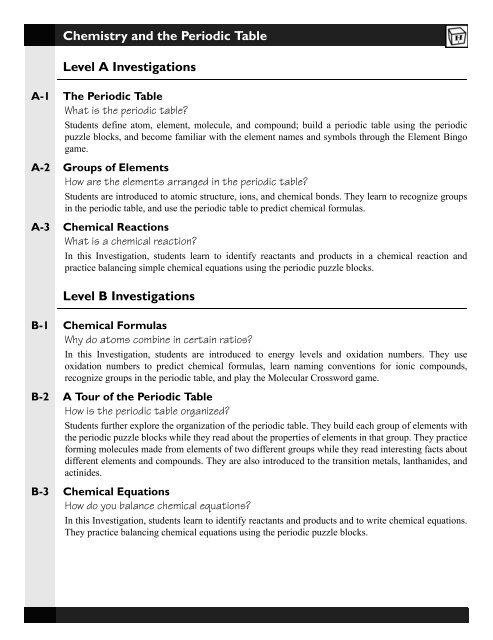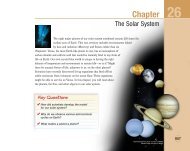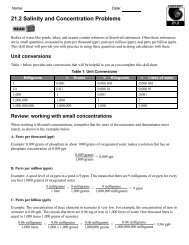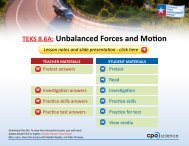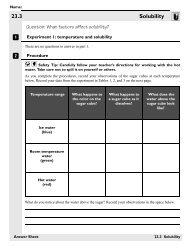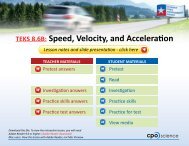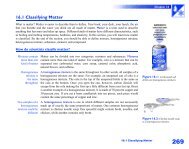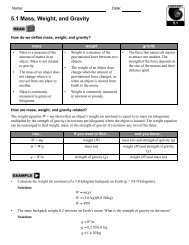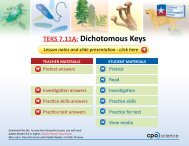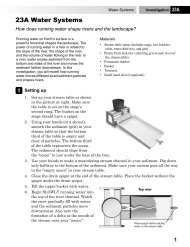Create successful ePaper yourself
Turn your PDF publications into a flip-book with our unique Google optimized e-Paper software.
Level C <strong>Investigation</strong>sC-1 Electrons and the Periodic TableWhat electrons have to do with the periodic table?Students learn how electrons are organized in the energy levels. The build the periodic table out ofperiodic puzzle blocks and write the electron configurations of all of the elements. They discover thatthe groups of the periodic table are arranged according to the number of valence electrons. Theypractice predicting and writing chemical formulas based on an understanding of the octet rule.C-2 Challenging Chemical EquationsHow do you balance difficult chemical equations?In this <strong>Investigation</strong>, students learn to identify reactants and products and to write chemical equations.They practice balancing challenging chemical equations using the periodic puzzle blocks.C-3 Classifying ReactionsHow can you predict the products of a chemical reaction?Students learn to identify five types of reactions, predict the products of a reaction given the reactants.They use the puzzle blocks to predict the products in reactions, given only the reactants, and to writethe balanced chemical equation for each reaction.
A-3 Chemical ReactionsQuestion: What is a chemical reaction?In this <strong>Investigation</strong>, you will:1. Define reactant, product, and chemical reaction.2. Learn to balance chemical equations.In the previous <strong>Investigation</strong>, you learned that atoms combine to form molecules. Nowwe will investigate how those combinations take place through chemical reactions.AWhat is a chemical reaction?Sodium and chlorine combine to form sodium chloride, ortable salt. We call this process a chemical reactionbecause the atoms that we start with rearrangethemselves and form new bonds with other atoms. It isimportant to remember that the numbers and kinds ofatoms don’t change; instead they are just rearranged.We call the ingredients that go into the reaction thereactants. The material or materials that we end up withare called the products.a. What are the reactants in the chemical reaction above?b. What are the products?BIdentifying reactants and products of chemical reactionsa. Octane is a major component of gasoline. When octane is burned in the presence ofoxygen, carbon dioxide and water are formed. What are the reactants in this chemicalreaction?b. What are the products of the octane-burning reaction?1
CWriting chemical equationsWe can show what happens during a chemical reaction by writing a chemical equation.Writing chemical equations is a lot like writing mathematical equations. To write achemical equation, we use the symbols for the elements and compounds involved in thereaction. The reactants are shown on the left side of the equation, followed by an arrow,and then the products on the right side.Remember that sodium reacts with chlorine to form sodium chloride, or table salt. Wemight write the chemical reaction for table salt like this:A-3to show that we started with sodium (Na) and chlorine (Cl) and ended up with salt(NaCl). The only problem with this equation is that chlorine is not available in the atomicstate. Pure chlorine exists in pairs of atoms that we call diatomic molecules. Theformula for diatomic chlorine is Cl 2 . Therefore we write the left side of the chemicalequation like this:Take three periodic puzzle blocks to represent the reactants above: One sodium block andtwo chlorines joined together to represent a molecule. Rearrange them to make salt.What is the happens?The rule for chemical equations is that you have to use all the atoms you start with, andyou cannot add extras or have leftovers at the end. In other words, chemical equationsmust always balance.Since chlorine comes in molecules containing two atoms, we need to have two sodiumatoms to match up with the two chlorine atoms in the diatomic molecule.Now add another sodium block to the three blocks you already have. Let the chemicalsreact! Does your equation balance now?a. How many sodium atoms do you need to complete the equation?b. How many molecules of sodium chloride are formed in the equation?To write the complete, balanced equation for this reaction, we place numbers in front ofthe reactants and products to show how many of each are required. These numbers arecalled coefficients. If the number of reactants or products is one, we do not use acoefficient (or write the 1). The complete, balanced equation for the formation of sodiumchloride is:2
DBalancing chemical equationsLet’s try another reaction. Combine hydrogen gas (which is also a diatomic molecule, H 2 )with carbon (C) to make methane (CH 4 ). First pick out some hydrogen and carbon blocks,and then try setting up the reactants. Remember that you must be able to rearrange allthe reactant atoms to get complete products. Which of these reactant combinationsworks?A-3Write the balanced chemical equation for making methane from hydrogen gas andcarbon.3
EMore equations to balanceLet’s balance some other chemical equations. The following equations have the properreactants and products. First assemble the reactants out of blocks, then rearrange themto make products. Figure out the right number of each reactant and product to make thechemical equation balance. Fill in the numbers in the boxes below. If there is only onereactant or product required, do not write the 1. The first one is done for you.A-3Hydrogen reacts with oxygen to produce water:2 H 2 O 2 2 H 2 OCarbon reacts with oxygen to produce carbon dioxide:C O 2 CO 2Aluminum ore is heated to produce aluminum metal and oxygen gas:Al 2 O 3 Al O 2Methane (natural gas) burns in oxygen to produce carbon dioxide and water:CH 4 O 2 CO 2 H 2 ONitrogen gas reacts with hydrogen gas to produce ammonia:N 2 H 2 NH 3Carbonic acid in soda pop breaks down to produce water and carbon dioxide (thebubbles in your soda!):H 2 CO 3 H 2 O CO 24
Name:A-3 Chemical ReactionsQuestion: What is a chemical reaction?A-3AWhat is a chemical reaction?a. What are the reactants in the chemical reaction above?b. What are the products?BIdentifying the reactants and products of chemical reactionsa. Octane is a major component of gasoline. When octane is burned in the presence ofoxygen, carbon dioxide and water are formed. What are the reactants in this chemicalreaction?b. What are the products of the octane-burning reaction?CWriting chemical equationsa. How many sodium atoms do you need to complete the equation?b. How many molecules of sodium chloride are formed in the equation?A-3 Chemical Reactions Answer Sheet
DBalancing reactionsa. Write down the equation for making methane from hydrogen gas and carbon.A-3EMore equations to balanceHydrogen reacts with oxygen to produce water:2 H 2 O 2 2 H 2 OCarbon reacts with oxygen to produce carbon dioxide:C O 2 CO 2Aluminum ore is heated to produce aluminum metal and oxygen gas:Al 2 O 3 Al O 2Methane (natural gas) burns in oxygen to produce carbon dioxide and water:CH 4 O 2 CO 2 H 2 ONitrogen gas reacts with hydrogen gas to produce ammonia:N 2 H 2 NH 3Carbonic acid in soda pop breaks down to produce water and carbon dioxide (thebubbles in your soda!):H 2 CO 3 H 2 O CO 2A-3 Chemical Reactions Answer Sheet
QuestionsA-31. Hydrochloric acid (HCl) is a substance produced by your stomach to help break downfood. Sometimes, if you eat spicy foods or worry too much about your upcoming sciencetest, your stomach produces too much hydrochloric acid and you get heartburn. Manypeople take antacids to relieve this painful condition. Antacids commonly contain calciumcarbonate (CaCO 3 ) which neutralizes the hydrochloric acid. The products formed arecalcium chloride (CaCl 2 ), carbon dioxide (CO 2 ), and water (H 2 O).a. What are the reactants in this chemical reaction? What are the products?b. Write the chemical equation for the heartburn reaction in words.c. Now write the equation again, using the chemical symbols for each molecule in thereaction. Use an arrow to represent the words “to produce.”d. Fill out the table below to determine the number of each type of atom on the reactantand on the product side. Hydrogen is done for you.atom reactants productsH 1 2ClCaCOe. Use the chart above to help you balance the equation. Remember, you can change thecoefficients in front of a molecule, but you can’t change the subscripts. Write thebalanced equation for the heartburn reaction.A-3 Chemical Reactions Answer Sheet
2. Balance the following equations. Make your own charts like the one in step 1e to helpyou.A-3Na 2 SO 4 BaCl 2 BaSO 4 NaClZnS O 2 ZnO SO 2NH 3 O 2 NO H 2 OAl Br 2 AlBr 3GaBr 3 Cl 2 GaCl 3 Br 2Mg 3 N 2 HCl MgCl 2 NH 3A-3 Chemical Reactions Answer Sheet
Curriculum Resource Guide: Periodic PuzzleCredits<strong>CPO</strong> <strong>Science</strong> Curriculum Development TeamAuthor and President: Thomas Hsu, Ph.DVice Presidents: Thomas Narro and Lynda PennellWriters: Scott Eddleman, Mary Beth Abel, Lainie Ives, Erik Benton andPatsy DeCosterGraphic Artists: Bruce Holloway and Polly CrismanCurriculum ContributorsDavid Bliss and David LampTechnical ConsultantsTracy Morrow and Julie DaltonCurriculum Resource Guide: Periodic PuzzleCopyright 2002 Cambridge Physics OutletISBN 1-58892-040-22 3 4 5 6 7 8 9 - QWE - 05 04 03All rights reserved. No part of this work may be reproduced or transmitted in any form or by an means,electronic or mechanical, including photocopying and recording, or by any information store or retrievalsystem, without permission in writing. For permission and other rights under this copyright, please contact:Cambridge Physics Outlet26 Howley Street,Peabody, MA 01960(800) 932-5227http://www.cpo.comPrinted and Bound in the United States of America


